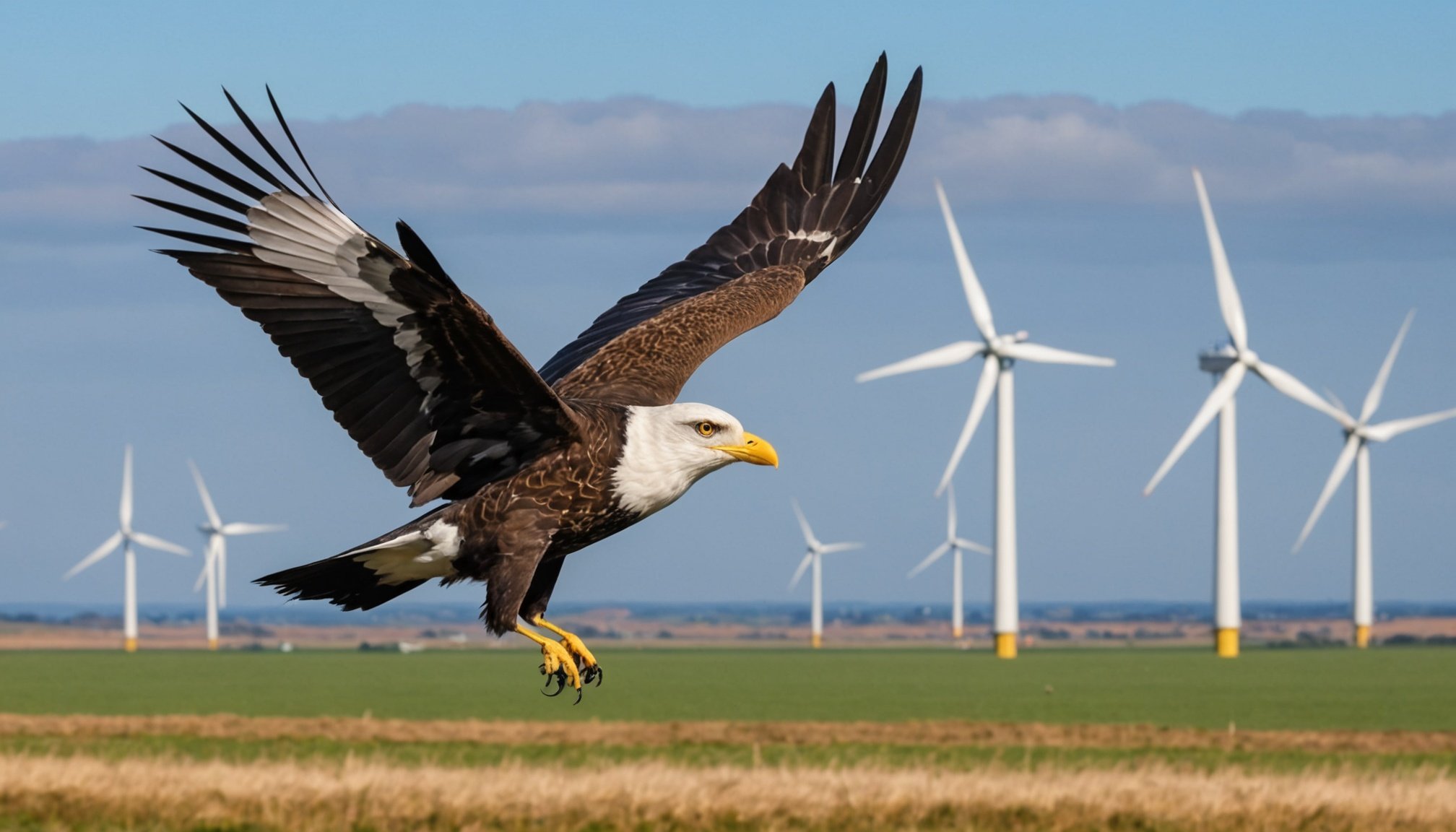Overview of Bird Strikes in Wind Farms
Understanding the scale and impact of bird strikes in wind farms is essential. As renewable energy sources like wind turbines proliferate, collision statistics have become a focal point for conservationists and researchers. Bird strikes occur when birds collide with turbines, posing significant threats to vulnerable species and prompting a need for detailed collision statistics.
Data collection efforts reveal sobering numbers: thousands of birds fall victim to wind turbine collisions annually. Despite variations across locations and species, the impact remains a consistent concern for wildlife populations. These statistics underscore the crucial role of monitoring and reporting to inform mitigation strategies.
This might interest you : Key strategies for ensuring safety during animal escapes at uk wildlife parks
One of the principal challenges is accurately assessing the overall impact of these collisions. Factors like differing wind farm environments, migratory patterns, and species-specific vulnerabilities contribute to the complexity of former assessments. Consequently, addressing bird strikes requires a multifaceted approach.
Further complicating this issue is the lack of standardised reporting methods across regions. This variability hinders comprehensive global analysis, prompting calls for unified protocols. Understanding such challenges is paramount in fostering initiatives aimed at reducing fatalities and ensuring the sustainable growth of wind energy without compromising biodiversity. Solutions will require localised strategies combined with broader policy interventions.
This might interest you : Exploring how urban greening projects enhance bird diversity in uk city centers
Innovative Research Initiatives by UK Scientists
In the quest to mitigate bird strikes in wind farms, UK scientists are spearheading several innovative research initiatives. Their efforts are pivotal in developing strategies that reduce bird collisions and promote coexistence between wind energy development and wildlife conservation.
Key research projects often involve collaboration between universities and conservation organisations, creating a rich synergy of expertise. For example, partnerships between academic entities like the University of Exeter and conservation bodies such as the Royal Society for the Protection of Birds (RSPB) are leading to groundbreaking advancements in this field.
Insights from leading scientists continue to shape these projects. Dr. Todd Thompson, an avian ecology expert, highlights the importance of understanding species-specific vulnerabilities to formulate effective solutions. His research focuses on collision modelling to predict hotspots of bird activity and evaluate mitigation measures beforehand.
Furthermore, many studies emphasize the importance of a multi-disciplinary approach, incorporating ecological, technological, and social perspectives. By leveraging diverse areas of expertise, UK scientists are not only addressing current challenges but also paving the way for future innovations in bird strike mitigation. These efforts reflect a growing commitment to seamlessly integrate renewable energy solutions with the need to protect vulnerable wildlife.
Technological Innovations for Bird Detection
Advancements in bird detection technology have opened new avenues in preventing bird collisions with wind turbines. Sophisticated monitoring systems are now equipped to detect and process avian movements, enhancing collision prevention efforts.
Radar Systems
Radar technologies offer robust solutions for bird detection. By tracking avian movements, these systems provide data essential for mitigating potential strikes. This technology is particularly beneficial in identifying bird flocks from afar, allowing preemptive action to be taken. Case studies highlight successful implementations where radar systems have significantly reduced bird fatalities by alerting wind farm operators in real time.
Optical Sensors
The integration of AI and machine learning into optical sensors has revolutionised bird monitoring. These systems analyse visual data to identify and predict bird behaviour around turbines. When compared to traditional methods, optical sensors provide a higher precision rate, delivering more reliable collision prevention strategies. Their ability to discern species-specific patterns enhances the efficiency of these systems, making them indispensable in modern bird strike prevention.
Drones in Monitoring
Drones have emerged as invaluable tools for real-time bird movement analysis. Equipped with advanced sensors, they offer dynamic tracking and early warning capabilities. Their agility allows them to survey large wind farm areas promptly, contributing to effective preventive measures. The deployment of drones has demonstrated a marked improvement in early warning systems, reinforcing their role in safeguarding avian wildlife.
Behavioral Modifications to Reduce Strikes
Efforts to minimize bird strikes in wind farms have increasingly turned towards bird behavior modification and habitat management. By understanding avian habits and migration patterns, researchers are developing strategies that can significantly reduce collisions.
Altering Wind Farm Layouts
Researchers are exploring modifications in wind farm layouts to minimize collisions. This includes strategic turbine placement and adjusting the layout according to migratory paths, which helps in reducing the likelihood of bird strikes.
Habitat Enhancements
Habitat management plays a crucial role in encouraging birds to avoid dangerous areas. By creating attractive safe zones away from turbines, the risk of collisions can be significantly reduced. This involves managing surroundings to provide suitable habitats that naturally deter birds from hazardous turbine proximities.
Behavioral Deterrents
Another promising area is the development of behavioral deterrents. These involve techniques like acoustic deterrents, which use sound to guide birds away from danger zones, or visual modifications on turbines to make them more visible to birds. Their effectiveness, though variable, is a critical part of ongoing research into comprehensive mitigation strategies.
Through these measures, the aim is not only to protect wildlife but to promote sustainable coexistence with expanding renewable energy infrastructure.
Case Studies and Success Stories
Examining case studies of successful projects offers invaluable insights into effective bird strike mitigation strategies in wind farms. These real-world examples showcase how innovative approaches can significantly reduce avian collisions.
One notable success story comes from a wind farm in Southern Scotland. By integrating advanced radar systems and adjusting turbine operations during peak migratory periods, they achieved a 40% reduction in bird strikes. This illustrates the impact of combining technological solutions with adaptive management practices.
Another example is a coastal wind farm in the Netherlands, which implemented habitat management strategies. By enhancing nearby wetlands, they encouraged alternative safer routes for birds, successfully decreasing collision rates by 30%. Their approach highlights the importance of understanding local ecology and tailoring interventions accordingly.
Lessons learned from these initiatives underscore the value of collaboration among scientists, conservationists, and engineers. The involvement of local communities also proved crucial, fostering a sense of shared responsibility and enhancing project acceptance.
Overall, these best practices demonstrate the potential for reducing bird strikes, offering a blueprint for other regions. By analyzing such case studies, stakeholders can refine their strategies, leading to more effective and sustainable coexistence between renewable energy infrastructure and wildlife conservation.
Implications for Wildlife Conservation and Energy Practices
Balancing wildlife conservation with the growth of renewable energy poses distinct challenges. As wind farm technologies advance, stakeholders face the pressing task of aligning industry practices with ecological priorities. Integrating comprehensive mitigation measures is paramount in achieving this balance.
The potential long-term impacts of these strategies on bird populations are significant. By implementing innovative approaches, such as bird monitoring systems and habitat management techniques, we can reduce the negative effects on avian wildlife while promoting sustainable energy solutions. It’s crucial that ongoing efforts prioritize minimizing disruptions to vulnerable species.
For wind farm planning, recommendations suggest adopting adaptable strategies that incorporate ongoing research findings. This includes fostering environments that facilitate the coexistence of birds and turbines, and employing technologies with a proven track record of mitigating bird strikes.
To ensure success, collaboration between policymakers, scientists, and industry leaders is essential. This unison can drive the development of standardized practices, potentially leading to comprehensive guidelines that promote both energy advancement and wildlife protection. Future wind energy development must remain steadfastly committed to integrating these dual objectives, ultimately paving the path for an industry that supports ecological sustainability alongside its technological ambitions.
Future Directions in Bird Strike Research
Exploring future research avenues offers promising potential for reducing bird strikes while advancing renewable energy. The development of emerging technologies like AI-driven monitoring systems and autonomous drones is crucial. These technologies are designed to provide real-time data and predictive analytics to prevent potential bird collisions effectively. As these technologies advance, user-friendly interfaces could empower wind farm operators with actionable insights, ensuring timely intervention.
Ongoing studies are pushing the boundaries of what’s feasible by integrating multi-sensory detection systems. Researchers are examining the integration of audio and visual systems that can create a comprehensive framework for bird detection. The potential to combine these sensory inputs with AI could significantly increase detection accuracy. Thereby reducing bird strike incidences more efficiently.
Public policy plays a pivotal role in supporting these research initiatives. Offering subsidies or incentives can motivate wind farms to invest in new technologies. Public awareness campaigns also emphasize the importance of such innovations in striking a balance between energy development and wildlife conservation.
Collaboration between scientists, government, and industry stakeholders is imperative. By fostering partnerships, more holistic approaches can be developed, creating standardized protocols that align ecological and energy goals. Such cooperation ensures that future research initiatives remain sustainable and impactful.











